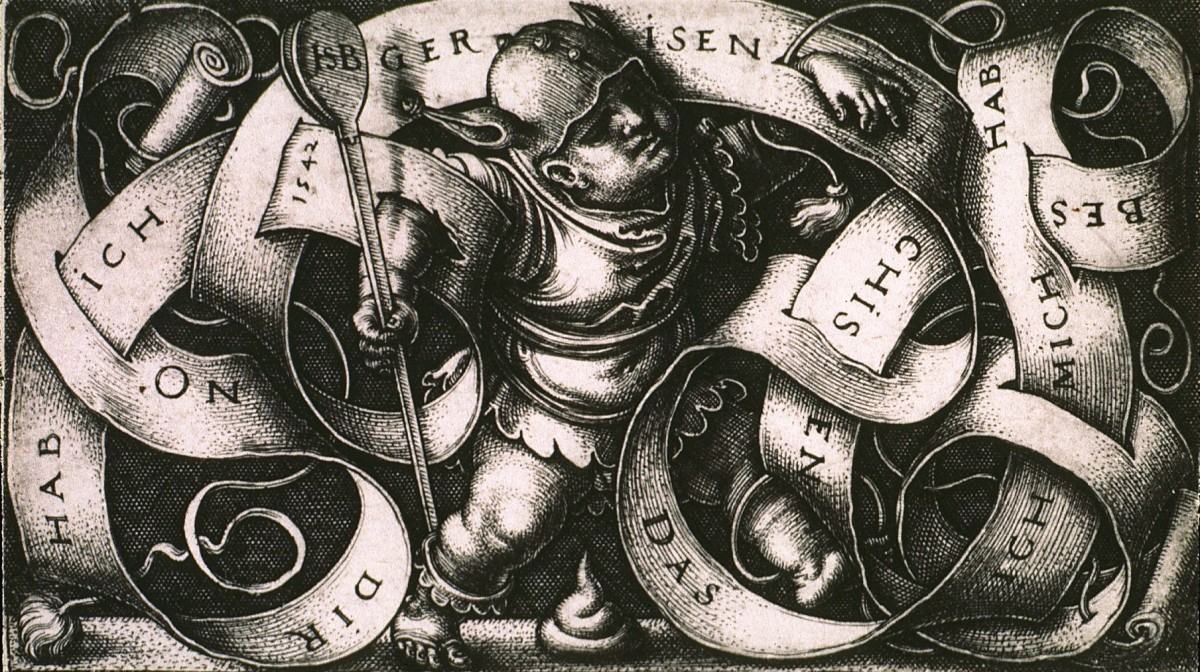Art Pick of the Week: The Little Buffoon
Every week we’re sharing one of our favourite artworks from the AGO Collection for you to see on your next visit. If you need directions to find it, simply ask when you arrive!

I have written on you that I have beshit myself.
No, we haven’t made a blunder – we’re introducing you to this week’s Art Pick, The Little Buffoon (1542), on view during Open Door Wednesdays from 1 to 4:30 pm in the Marvin Gelber Print & Drawing Study Centre. The crude phrase you just read (and probably frowned upon, sorry) is what’s written in German on the banner entwined with the cute, cherub-like character – but take a closer look and you’ll see he’s no angel.
Measuring just 4.5 x 8 cm, this extraordinarily petite work is an easy-to-miss (but unforgettable) engraving on laid paper by painter and printer Hans Sebald Beham. Born in 1500 in Nuremburg, Germany to a family of artists, Beham was part of a group called the “Little Masters” (Kleinmeister in German), named for their finely detailed work on canvasses not much larger than a postage stamp. Throughout his career, Beham produced over 2,000 prints.
He and his brother, along with another artist, George Pencz, were banished from Nuremburg in 1525 for heresy. The trio had expressed opinions against the new Lutheran orthodoxy that was prominent in the city, and were thus dubbed the “Godless Painters” during an inquest. After returning a few years later, Beham was exiled once again, in 1528, for plagiarizing an unpublished manuscript by Albrecht Durer, who had recently died and was a major influence on Beham.
Regardless of his thoughts on religion, the subjects of Beham’s works featured scenes from the Old and New Testaments, the lives of saints, portraits of historical subjects and other classical themes and motifs, often with a touch of erotica. Beham’s engravings also focused on scenes of peasant life and mythology.
The Little Buffoon is a monochromatic print that shows a man wearing a helmet with donkey ears and bells attached. He also has a jester costume on, complete with frills, and holds a spoon-like sceptre on which the artist signed his initials (HSB). The fool’s clumsy limbs are held askew, having torn through a banner, and his bare left foot is raised in a march – or, more likely, a stomp. And, between his legs, there is a steaming pile of poop.
If you follow the flow of the ribbon from where it begins on the top left, the words On dir hab ich gerisen das ich mich hab beschisen are found throughout the piece, translating to the very literal statement that you read above. The chaotic cheekiness of the piece shows toilet humour that was common at the time, and with the depiction of his carefree, fearless attitude, you can’t say that the little buffoon (or, perhaps, Beham himself) had any shame in this declaration – and defecation.
Stay tuned for next week’s Art Pick.
Admission to the AGO Collection and all special exhibitions is always free for AGO Members, AGO Annual Pass holders and visitors 25 and under.
